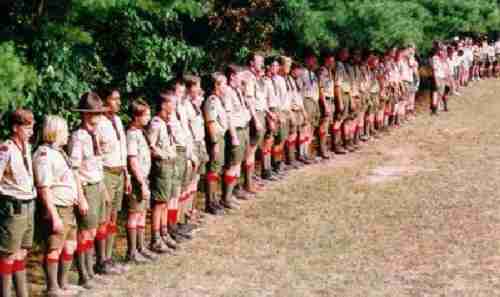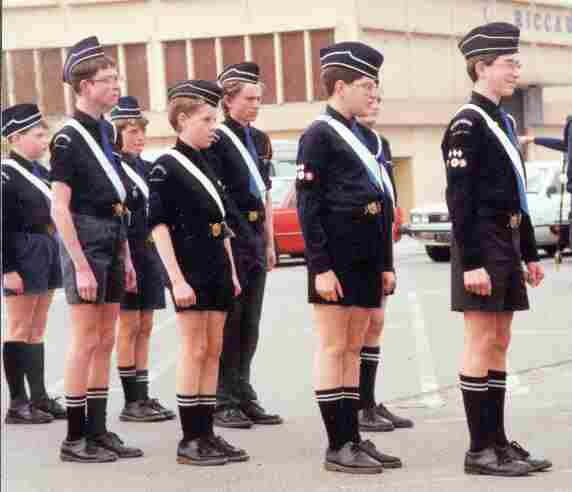
Figure 1.--Many Scout associations around the world demphazied the uniform during the 1990s. Scouts Associations in some countries, like Hong Kong, still give considerable attention to the uniform.


Figure 1.--Many Scout associations around the world demphazied the uniform during the 1990s. Scouts Associations in some countries, like Hong Kong, still give considerable attention to the uniform. |
Note: I'm just beginning the chronological pages. Do let me know if you have any historical background or information on uniforms that should be added.
The Young Pinoeers had for decades been one of the two major youth groups around thw world. While HBU does not have actual numbers, more boys in the second half of the 20th century may have participated in the Communist Young Pioneers than Scouting. Membership in the Pioneers was virtually required and given the population of China and the Soviet Uniion alone, this would mean massive numbers of boys and girls. This all changed in the late 1980s and eraly 90s with the fall of Communism in Europe. This culminated with the disolutioin of the Soviet Union at the end of 1991. One of the casualties of the colapse of Communism was the Pioneer movement. Denied direct Government support, the Pioneer mpvement in each European country disappeared. (I'm not sure about Serbia.) Only where Communism continues (China, Cuba, North Korea, and Vietnam) does the Pioneer movement continue. Interestingly while a vast literature exists on Scouting as well as inumerable internet sites, very little information exists today on Pioneering. HBC is very interested in hearing from former Pioneers, but very few former members appear interesting in discussing their experiences.
Communists like other totalitarian governments maintained complete control over education and all youth organizations. With the fall of Communism, independent youth groups were allowed to organize. The World Scout Organization (WSO) reports that Since 1990, 30 new member countries have joined or rejoined the WSO following the collapse of communist regimes. (One reason that this number is so large is that the Soviet Union was composed of 16 republics which became independeny countries, and a national Scout association has been organized in each. At the end of the decade, there were more than 25 million Scouts in 216 countries and territories. Only five countries do not have Scouting: four comminist countries (China, Cuba, North Korea, and Viet Nam) and Myanmar (formerly Burma).
One continuing trend observable in the 1990s was the continuing decline in the popularity of uniforms--especially in Europe. Uniforms were once a major attraction for boys interested in joining a youth youth group. The uniform was once an aspect of Scouting that attracted boys. This gradually changed. Boys were much less interested in uniforms. Beginning in the 1970s an observable pattern in Europe was a decline in the attention to wearing uniform among some European Scouts. Many European Scout groups gave virtually no attention to uniforms.By the 1990s some Scouts groups had virtually abandoned uniforms--although boys might wear knerchiefs. This trend was not nearlly observable in some other areas. Asian Scouts still wore uniforms. Scout uniforms were still widely worn in Asia. American Scouts were one exception to the tendency of groups around the world to deemphasize the uniform. American Scouts also sill commonly wore uniforms--although standards varied from group to group.
The World Scouts in 1991 held the 17th World Jamboree at the Soraksan National Park in South Korea. It was attended by 1,010 American Scouts totaling 19,083 Scouts from 135 countries. The World Scouts in 1995 held the 18th World Jamboree in Holland. The attendance totaled 29,066 Scouts from an amazing total of 166 different countries. The World Scouts are planning the 19th World Jamboree in Picarquin, Chile during 1999.
The BSA in 1990 presented Pope John Paul with the distinguished Citizen of the World Commendation. The 10th edition of the Boy Socut Handbook was introduced in 1990.
The BSA in 1990 opened the Center for Professional Development in Westlake, TX. The BSA in 1991 introduced the Learning For Life program. The BSA in 1991 introduced the Ethics In Aciton and the Family programs. The BSA also published the Conservation Handbook in 1991. The BSA in 1991 developed the Trail Boss program. The BSA in 1992 reduced the six BSA regions to four. William Green Bar Bill Hillcourt passed away in 1992. The BSA started the Cub Scout Academics program in 1992. The BSA in 1993 held the 13th National Jamboree at Fort A.P.Hill, VA which was made the permanent Jamboree site. The attendance totaled 32,000. Thee BSA held the 14th National Jamboree in 1997 at Fort A.P.Hill, VA.
One Belgian Scout group, the VVKSM, for example, suggests that its uniform be referred to as "movement attire" is is perhaps a better word than "uniform"; more inviting, more creative, friendlier. (Note: the idea of a uniform does not apparently appeal to European children. Thus the semantically more appealing "movement attire". The group actually has a more formal uniform than many European Scouts. Boys and girls from the different branches wear the same basic gear: a beige shirt in sturdy, natural cotton, a dark green woollen sweater, and green denim trousers (long or short) or skirt. All the uniform items bear the VVKSM logo. So it is a real "scout" look. The groups, however, stresses flexibility. The group itself can prescribe its own particular style. There has to be flexibility: sending a cub home just because he isn't wearing his cap would be much too rigid. You can ask your members to wear the group style, but it must remain attractive. The basic uniform is the same for cubs, brownies, junior guides, junior scouts, guides, scouts, and leaders: beige shirt, green sweater, green long trousers or short trousers or skirt, belt, neckerchief and woggle and, where appropriate, green or beige socks. The "rascals" don't have a specific uniform. The uniform items can be worn in various combinations and "whimsical variations". This is a major departure from traditiinal Scouting, when "whimsical variations" were hardly encouraged.

Figure 2.--While many European Scout groups demphasized uniforms, many American Scout units continued to insist on proper uniforming. |
Many boys' uniformed groups reforted major changes in their uniforms during the 1990s. The majot trends were similar despite differences in the uniform. The changes were dominated by changes in Scout uniforms, the dominate uniformed boys' oeganization.
Many Scout groups, especially in Europe, discontinued wearing uniforms in the 1990s. European boys in particular appear to dislike the idea of wearing a uniform. Many groups dress as the individuals desire. Some might wear kerchiefs to indicate that they are Scouts, but no other item of the Scout uniform. Some countries continue to give considerable attention to the uniform. American Scouts, for example, still usually wear the uniform. American Scouts were one of the countries where Scouts still gave considerable attention to uniform, although this varied substantially from unit to unit. One notice trend among American and other Scout groups that still had short pants uniforms, was a much longer and baggier cut.
One natioanlist group in Flanders (Belgium), the VJR, was an exception to the trend in many youth groups to deemphasize uniforms. The VJR continues to insist on a traditional uniform of kerchief and short pants did not adopt the increasingly popular long, baggy short style adopted by many youth groups during the 1990s.

Figure 3.--Boys Brigade uniforms tend to be blue. In the 1990s, only the New Zealand Brigaders still wore short pants uniforms. |
Most Boys' Brigade units around the world wore blue uniforms with white trim, although there were variations from country to country. All units had blue uniforms. English Brigaders wire light blue shirts and dark blue pants. New Zealand Brigaders wore dark blue shirts and pants--with white belts. Most units had had adopted long pants uniforms in the 1970s or 80s. Only New Zealand Brigaders, to HBU's knowledge, continued to wear a short pants uniform during the 1990s.
Navigate the Historic Boys' Uniform Chronology Pages:
[Return to the Main chronologies page]
[The 1900s]
[The 1910s]
[The 1920s]
[The 1930s]
[The 1940s]
[The 1950s]
[The 1960s]
[The 1970s]
[The 1980s]
[The 1990s]
[The 2000s]
Navigate the Historic Boys' Uniform Web Site:
[Introduction]
[Bibliographies]
[Chronologies]
[Contributions]
[FAQs]
[Garments]
[Organizations]
[Boys' Uniform Home]
Navigate the Historic Boys' Uniform Web organizatiion pages:
[Boys' Brigade]
[Camp Fire]
[Hitler Youth]
[National]
[Pioneers]
[Royal Rangers]
[Scout]
